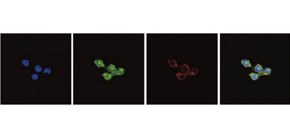
The subcellular dynamics of RNA stabilizing molecule in response to inflammation
Inflammation is regulated by the balance of accelerator and brake
Points
- •Arid5a *1 ) contributes to augmentation of inflammatory cytokine serum levels in vivo .
- •Arid5a translocates to the cytoplasm from the nucleus in response to inflammation.
- •The nucleocytoplasmic translocation of Arid5a is regulated by importin-α/β1 and CRM1.
- •CRM1 Inhibitor, Leptomycin β, inhibited the nuclear export of Arid5a and IL-6 *2 ) production after LPS stimulation.
Summary
Tadamitsu Kishimoto (Professor, Immunology Frontier Research Center (IFReC), Osaka University) and his research group revealed the regulatory mechanism of subcellular localization of Arid5a in response to inflammation. It had been known that an inflammatory accelerator, Arid5a, is localized in the nucleus, and an inflammatory brake, Regnase-1 *3 ), is localized in the cytoplasm. In this study, they showed that 1) Arid5a translocates to the cytoplasm from the nucleus in response to inflammation, 2) bimax, which inhibits cNLS-dependent nuclear import via high-affinity interactions with NLS-binding sites of importin-α, inhibits the nuclear import of Arid5a, and 3) a CRM1 inhibitor, Leptomycin B, inhibits the nuclear export of Arid5a after LPS stimulation.
Background
Macrophages produce inflammatory cytokines to activate other immune cells and exclude pathogens. However, over- or chronic inflammation causes diseases including septic shock or autoimmunity. Therefore, the group studied the control mechanism of inflammation, especially focusing on the posttranscriptional regulation of the Il6 mRNA by Arid5a and Regnase-1. Their previous study showed that Arid5a binds to Il6 mRNA 3′UTR to inhibit Regnase-1-mediated
RNA decay. Additionally, Arid5a deficient mice showed down-regulated inflammatory cytokine production, resistance to septic shock, and bleomycin-induced lung injury. Although Arid5a is known to play an important role in immune regulation, whether and how Arid5a subcellular localization impacts immune regulation has remained unclear.
Significance of the findings
The group showed that Arid5a translocates from the nucleus to the cytoplasm after LPS stimulation. Since the inhibition of Arid5a nuclear export causes the significant suppression of IL-6 production, further understanding of Arid5a dynamics may lead to novel therapeutic strategies for septic shock or autoimmune diseases.

Figure: Model of inflammatory response by Arid5a/Regnase-1. Regnase-1 localizes to the cytoplasm. Arid5a is imported to the nucleus via an importin-α/β1 pathway. In response to inflammation, the Toll-like receptor (TLR) is activated by LPS, and Il6 mRNA is induced by NF-κB. After that, Arid5a interacts with Il6 mRNA and is exported to the cytoplasm. Credit: M. Higa, Osaka University
Technical terms
*1) AT-rich interactive domain 5a (Arid5a)
A protein highly expressed in macrophages in response to lipopolysaccharide (LPS) that controls posttranscriptional regulation of IL-6 by stabilizing Il6 mRNA by binding to its 3′ UTR.
*2) Interleukin-6 (IL-6)
A pro-inflammatory cytokine discovered by Kishimoto Laboratory of Osaka University.
*3) Regnase-1
An enzyme that has been shown to destabilize Il6 mRNA by interacting with a conserved stem-loop motif in the 3′ UTR.
Article information
Journal: Proceedings of the National Academy of Science of the USA (PNAS) (online publishing on Jan. 22, 2018)
Title: “Regulation of inflammatory responses by dynamic subcellular localization of RNA binding protein Arid5a”
Authors: Mitsuru Higa, Masahiro Oka, Yoshitaka Fujihara, Kazuya Masuda, Yoshihiro Yoneda and Tadamitsu Kishimoto*.
* Corresponding author
Contact
Professor Tadamitsu KISHIMOTO,
Laboratory of Immune Regulation, Immunology Frontier Research Center (IFReC), Osaka University
E-mail: kishimoto@ifrec.osaka-u.ac.jp
http://www.ifrec.osaka-u.ac.jp/en/laboratory/tadamitsu_kishimoto/
